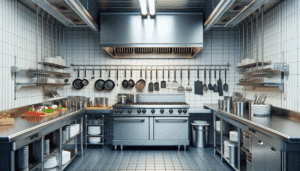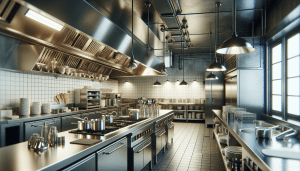In the world of commercial kitchen maintenance, keeping hoods and exhaust systems clean is essential for safety, efficiency, and compliance with regulations. As technology advances, so does the field of kitchen hood cleaning. Innovative solutions have emerged that not only improve the cleaning process but also enhance safety and environmental sustainability. In this article, we’ll explore some of the latest innovations in kitchen hood cleaning technology that are changing the game for professionals and businesses in the industry.
1. Ultrasonic Cleaning
Ultrasonic cleaning is a cutting-edge technology that has revolutionized the way kitchen hoods and exhaust systems are cleaned. It involves the use of high-frequency sound waves to create microscopic bubbles in a cleaning solution. These bubbles implode, creating powerful shockwaves that dislodge and remove grease, carbon, and other contaminants from surfaces.
The benefits of ultrasonic cleaning include:
- Efficiency: Ultrasonic cleaning is highly effective and can clean even the toughest grease buildup.
- Reduced Chemical Usage: Because ultrasonic cleaning relies on the mechanical action of bubbles, it often requires fewer chemicals, making it more environmentally friendly.
- Safety: It minimizes the need for manual scrubbing, reducing the risk of accidents and injuries.
2. Eco-Friendly Cleaning Agents
Environmental sustainability is a growing concern, and kitchen hood cleaning technology is following suit. Many companies are now using eco-friendly and biodegradable cleaning agents that are as effective as traditional chemicals but less harmful to the environment. These cleaning agents break down grease and grime without leaving behind toxic residues.
Benefits of eco-friendly cleaning agents include:
- Reduced Environmental Impact: They minimize the release of harmful chemicals into the environment.
- Healthier Indoor Air Quality: Eco-friendly agents contribute to better air quality in the kitchen.
- Regulatory Compliance: They align with regulations promoting environmental responsibility.
3. Remote Monitoring and Maintenance
Technology has made it possible to remotely monitor the condition of kitchen hoods and exhaust systems. IoT (Internet of Things) devices can be installed to track factors like airflow, temperature, and grease buildup. This data can be analyzed to schedule cleaning and maintenance more efficiently.
Advantages of remote monitoring and maintenance include:
- Proactive Maintenance: Issues can be identified and addressed before they become major problems, preventing costly downtime.
- Cost Savings: Efficient scheduling and targeted maintenance can reduce operational costs.
- Improved Safety: By ensuring that systems are in optimal condition, the risk of fires and accidents is minimized.
4. Energy-Efficient Exhaust Systems
Innovation in kitchen hood cleaning isn’t limited to cleaning methods alone. Energy-efficient exhaust systems are becoming more prevalent. These systems are designed to operate at variable speeds, adjusting airflow based on cooking activity. They reduce energy consumption, lower operational costs, and contribute to a greener kitchen.
Benefits of energy-efficient exhaust systems include:
- Cost Savings: Lower energy consumption results in reduced utility bills.
- Sustainability: They align with sustainability goals and reduce a kitchen’s carbon footprint.
- Regulatory Compliance: Many regions require the use of energy-efficient exhaust systems to meet environmental regulations.
5. Virtual Reality Training
Training is a crucial aspect of kitchen hood cleaning, and virtual reality (VR) technology is making it more engaging and effective. VR training allows technicians to practice cleaning procedures in a virtual kitchen environment, improving their skills and knowledge without the need for physical equipment.
Advantages of VR training include:
- Enhanced Learning: Technicians can practice in realistic scenarios, leading to better retention of knowledge.
- Safety: Training in a virtual environment reduces the risk of accidents during real-world cleaning.
In conclusion, innovations in kitchen hood cleaning technology are transforming the industry. Ultrasonic cleaning, eco-friendly agents, remote monitoring, energy-efficient exhaust systems, and virtual reality training are just a few examples of the advancements that improve efficiency, safety, and sustainability in commercial kitchens. As technology continues to evolve, kitchen hood cleaning will become even more effective and environmentally responsible.
To take advantage of these innovations and ensure your kitchen’s safety and compliance, consider partnering with a professional kitchen hood cleaning service like Utah Hood Cleaning. Contact us at 801-853-8155 or visit our website utahhoodcleaning.com to learn more about our services and the innovative cleaning solutions we offer.




